Crawler cranes: what are the latest launches?
17 November 2022
Versatile and increasingly compact for their performance, crawler cranes can be configured for a whole host of different projects, and new models are being launched to meet increasing market demands. Niamh Marriott reports.
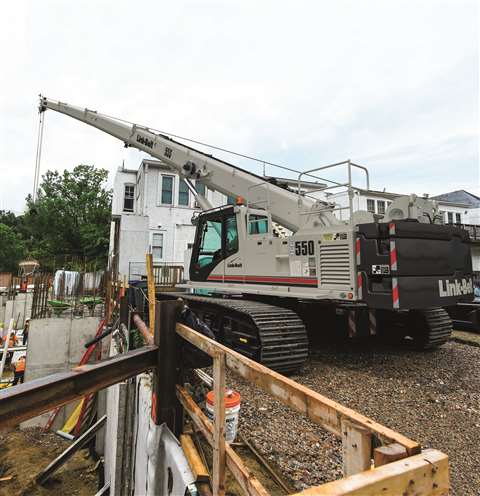 Link-Belt’s newest TCC-550 telescopic crawler crane. (Photo: Link-Belt)
Link-Belt’s newest TCC-550 telescopic crawler crane. (Photo: Link-Belt)
USA-based crane manufacturer Link-Belt Cranes says the greatest demand in the telescopic boom crawler crane market comes in the 80 to 140 US ton (73 to 127 tonne) range.
Bridge projects have been a notable sector for telecrawler growth in the last 18 months, the company says, as contractors continue to enjoy the ease with which telecrawlers can move in and around bridge overpasses and handle constraints of increasingly small jobsites.
Telecrawlers for wind turbine installation
Link-Belt says a “steady market that has seen growth for telecrawlers is in the wind sector where these units are used in tandem with large lattice crawlers for setup and initial handling of turbines.
Telecrawlers are easier to move over typically uneven terrain where wind projects exist and often do not require any dunnage or limited ground prep as crews move from turbine site to site.”
Link-Belt Cranes’ most recent crawler announcements are the new 55 ton (45 tonne) TCC-550 and 80 ton (75 tonne) TCC-800 telescopic crawler cranes.
The TCC-550 follows a long line of product improvements and introductions in Link-Belt Cranes’ telescopic crawler crane family, the company says. The TCC-800 was introduced at the ConExpo 2020 show in Las Vegas, USA.
The TCC-550 has a 36.5 to 115 foot (11 to 35 metre) four-section boom with two boom extend modes (EM1 and EM2).
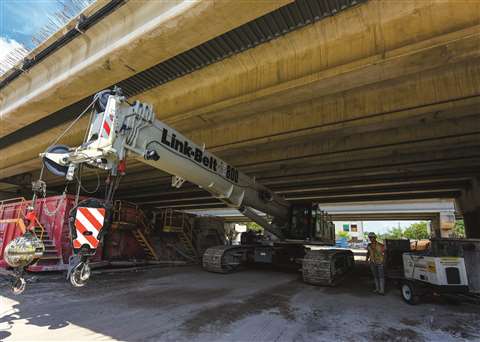 Link-Belt’s TCC-800 telescopic crawler crane was introduced at ConExpo 2020. (Photo: Link-Belt)
Link-Belt’s TCC-800 telescopic crawler crane was introduced at ConExpo 2020. (Photo: Link-Belt)
Fly options include a 28.5 to 51 foot (8.7 to 15.6 metre) two-piece bi-fold lattice fly offsetable to 2, 20 and 40 degrees; maximum tip height is 165.5 feet (50.44 metres).
The TCC-800 comes with a new four-section 38 to 120 foot (11.8 to 36.5 metre) full-power boom that reaches a maximum tip height of 184.5 feet (56.2 metres) with full boom and Link-Belt’s SmartFly pinning system.
Kobelco 200 tonne capacity crawler crane
A new 200 tonne capacity crawler crane has been launched by Japanese crane manufacturer Kobelco, the Mastertech 7200G NEO.
An updated model, the crane’s performance, including lifting capacity, transportability, ease of assembly, safety, comfort, and manoeuvrability have all been updated, and new operator assist functions have been added.
Lifting capacity has been increased by up to 10 per cent for the crane boom configuration and 25 % for the tower-luffing configuration, compared to the previous model. Currently, the crane is available for the Japanese market.
Heavy lifting: offshore and petrochemical sectors
Manufacturer Liebherr acknowledges that different markets are creating more demand for crawler cranes, particularly the petrochemicals industry and port handling, which involves enormous components for offshore applications.
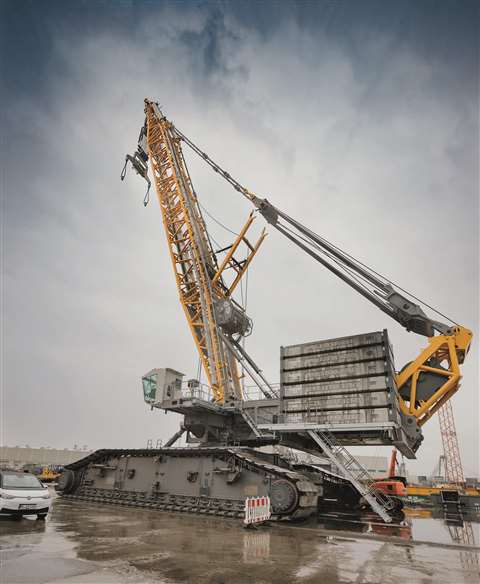 Liebherr’s new 2,500 tonner, the LR 12500-1.0, is designed to be compact when being transported. (Photo: Lieherr)
Liebherr’s new 2,500 tonner, the LR 12500-1.0, is designed to be compact when being transported. (Photo: Lieherr)
Driven by the energy revolution, the company says, load weights are increasing all the time, particularly when handling components for offshore wind turbines.
Liebherr has decided to meet this challenge with a new crawler crane – the LR 12500-1.0 will be added to the portfolio of lattice boom cranes between the 1,350 tonne capacity LR 11350 and the LR 13000, which has a lifting capacity of 3,000 tonnes.
The new crane has been designed as an economical crawler crane for global projects.
The maximum hook height of around 200 metres is achieved by the new LR 12500-1.0 using a 100 metre main boom and a 108 metre luffing jib. Installed with a short length, the luffing jib also acts as a WV jib.
The “vessel lifter” is ideal for the erection of long columns in petrochemical plants, Liebherr says.
Electric powered crawler crane
German manufacturer Sennebogen has announced a fully electrically powered crawler crane.
The 653 E Electro Battery is a 50 tonne capacity machine with a telescopic boom. It will be launched at bauma.
Combining the benefits of electric power with those of a telescopic crawler crane “means you work completely emission-free and remain maximally flexible thanks to the Dual Power Management System,” Sennebogen says.
As the first electric model in Sennebogen’s range it was developed in collaboration with Dutch Sennebogen dealer Van den Heuvel. “Through the close contact of Van den Heuvel with Dutch crane rental and construction companies, valuable market requirements from the progressive Dutch market were brought into the development partnership.”
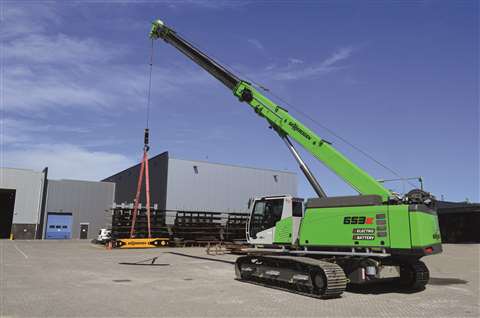 Sennebogen’s fully electrically powered crawler crane will be launched at bauma 2022. (Photo: Sennebogen)
Sennebogen’s fully electrically powered crawler crane will be launched at bauma 2022. (Photo: Sennebogen)
The crane’s 210 kW-h battery pack carried onboard in place of a diesel tank allows autonomous operation in battery-only mode, or it can be plugged into the mains electricity grid via a cable for use when stationary.
When plugged in the machine runs from this site power with any excess going to top-up the charge in the battery.
In addition to the crane emitting no engine exhaust at the point of use, it offers quieter and smoother operation than diesel-engined models. A further benefit is reduced maintenance in that, for example, there are no periodic engine oil and filter changes.
GTC-2000 telescopic crawler crane
Tadano’s GTC-1800EX telescopic crawler crane, which was launched in 2020, has since been renamed GTC-2000. The company is standardising the way it does its product naming nomenclature.
One of the largest telescopic boom crawler cranes in the market, the GTC-2000, offers a fully self-rigging operation and a maximum load moment of 585 tonne-metres.
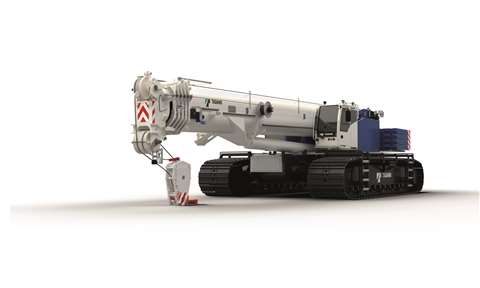 Tadano’s renamed GTC-2000 crawler crane. (Photo: Tadano)
Tadano’s renamed GTC-2000 crawler crane. (Photo: Tadano)
With its load chart and lifting capabilities, the GTC-2000 offers the capacity of 200 tonne class cranes when set up in many of its configurations.
For existing GTC-1800EX models already out in the field, Tadano will offer customers a kit to upgrade these cranes to the GTC-2000.
The field kit comes complete with upgraded software which includes new load charts, and there is crane documentation, manuals, decals and a nameplate.
STAY CONNECTED


Receive the information you need when you need it through our world-leading magazines, newsletters and daily briefings.
CONNECT WITH THE TEAM








